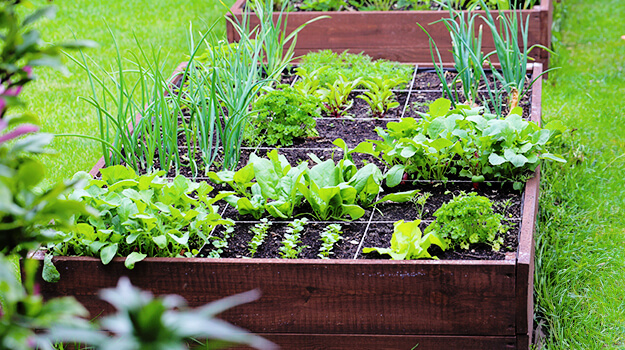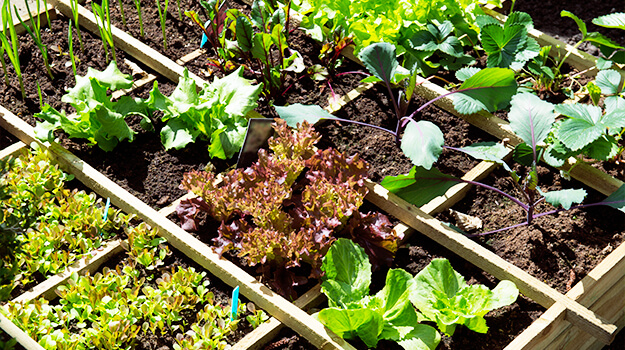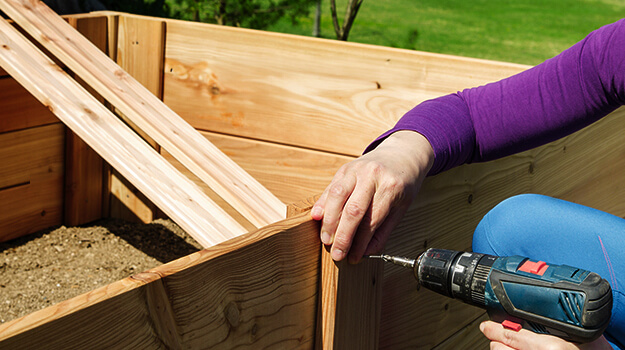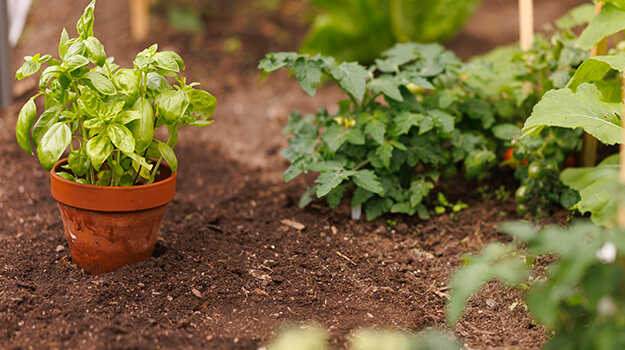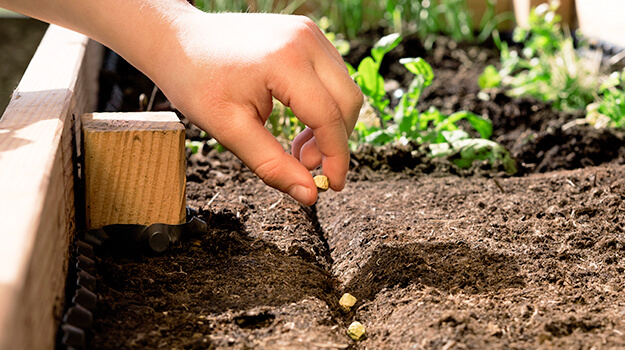- What is square foot gardening?
- Limiting the size of the garden
- How to build a square foot garden
- Plant spacing in square foot gardens
- How to plant vegetables
- Garden like a pro
- Companion planting
- Interplanting
- Succession planting
- Crop rotation
- Pest control in the garden
- Weed control in the garden
What’s not to love? There’s no tilling, no digging and there’s much less work. It’s a whole different approach to gardening. It’s more than just another method of planning and planting a garden.
Picture a garden that’s divided into a manageable size and shape that gardeners of all ages, sizes and levels of experience can understand and cope with easily. The square foot garden is suitable for both newbies and seasoned gardeners. In addition to that, you can incorporate practices such as companion and succession planting, interplanting and crop rotation. It is an efficient way to garden in limited spaces.
What is square foot gardening?
The system is simple, but versatile. It can be adapted to fit your particular gardening needs. Whether you want to grow just enough for a few salads a week, or grow a lot of all your own veggies, you will be able to adapt the principles of square foot gardening to meet your requirements.
The garden will end up being organized, easy to maintain, attractive and productive all season long.
Square foot gardening is based on a raised bed type of garden, typically a 4’ X 4’ box that is 6-12” high, filled with amended peat and compost, and afterwards divided into one-foot squares. On top of each frame, you need to place a grid that divides the garden box into one-foot squares. The grid is the unique feature that makes the whole system work so well. You end up with 16 one-foot squares in a 4’ X 4’ box.
Look at your 4’ by 4’ box with the grid on and imagine up to 16 different parcels of assorted vegetables. What you see before you is a neat, attractive, well-organized garden that will be easy to manage. If you were to remove the grid, it would be difficult to organize and manage this space so precisely. Anyways, without the grid you will be tempted to plant in rows, which is a poor use of space.
The grids can be made from nearly any material: wood lathes, narrow plastic electrical conduit pipes, old venetian blinds, strings, etc., and whatever you end up using, the grid must stay on all season long.
You can make the box longer, but not wider. The 4’ width makes the garden accessible from the sides without ever stepping into it, avoiding compaction of the garden soil. Different vegetables are planted in different blocks according to their size. For example, you can plant 16 carrots in one square, or 9 onions or just 1 broccoli. More on this later.
Limiting the size of the garden
The basic concept of growing more food in less space has been tried by many. The square foot garden establishes definite limits, or boundaries, within which you will garden. It limits the amount of space, and thereby time, you will devote to each vegetable, chore and step in the garden.
Newbies and seasoned gardeners alike will enjoy this easy-to-learn, easy-to-do method. It requires very little space: up to 80% less space than conventional gardening. It can be implemented in as little as 4’ by 4’ or even less. But then again, it can also be done as large as you want and produce 5 times more than a conventional garden in comparable space.
How to build a square foot garden
Build a square frame that is no wider than 4 feet, and 6 to 12 inches deep. For your first time, it is suggested to build a 4’ by 4’ frame. You can, of course, go smaller. Consider using 2” X 6”, 2” X 8” or 2” X 12” cedar planks or pressure-treated lumber.
Deck screws work best to fasten the boards together at the corners. Alternatively, most of the garden centres and home building stores sell a prefabricated 4’ X 4’ unit made of plastic, composite wood or real wood. With no tools, you can have a long-lasting garden easily assembled and ready to go.
Find a spot in your lawn that offers good drainage and 6-8 hours of direct sun per day, away from any tree roots that would encroach on your nice garden soil. For convenience, consider placing it as close as possible to the house.
You don’t need to dig up the lawn, simply cover it with cardboard or a layer of newspapers to discourage grass and weeds from coming up through. Now you need to fill the frame with a proper organic garden mixture that includes compost, peat moss and organic fertilizer (no topsoil needed).
Our bale of PRO-MIX Premium Organic Vegetable and Herb Mix provides the correct ratio of peat moss, compost and organic nutrients that the plants require. Plus, it contains mycorrhizae, a beneficial biostimulant long proven to enhance vigorous root development. Otherwise, you could hand mix ½ part compost with ½ part peat moss, and add an organic fertilizer. The compost will provide many nutrients, and the peat moss helps hold moisture and keeps the medium loose. A reminder: the system works without any regular topsoil. Peat moss, compost and organic nutrients will do the trick.
If stooping or bending is a problem, raise the boxes to a comfortable level. Some of the prefabricated raised gardens come with legs to raise the finished unit off the ground for easier accessibility for the elderly, the wheelchair-bound gardeners or folks that don’t want to be bent over when working in the garden. These units can also be used right on patios or decks.
Plant spacing in square foot gardens
Depending on the mature size of the plant, grow 1, 4, 9 or 16 equally spaced plants per square foot. For example:
- if the seed packet recommends plant spacing be 12 inches apart, plant one plant per square foot
- if 6 inch spacing, then 4 per square foot
- if 4 inch spacing, 9 per square foot
- if 2 inch spacing, 16 per square foot
See chart below.
How to plant vegetables
Plant one seed in each spot by making a shallow hole, as per the depth guideline on the seed packet. Cover, but do not pack the soil. Thinning overplanted seeds after germination (as with conventional seed planting) is all but eliminated. Seeds are not wasted.
Don’t overplant. Plant only as much of any one crop as you will use at one time. The only exception is if you are planting a quick harvest vegetable, such as mesclun mix lettuce, which can be seeded in a row, instead of planting individual seeds.
If you are planting vegetable seedlings/transplants instead of seeds, use the same plant numbers in each grid as the seed recommendation.
Some vine plants such as squash, cucumbers, melons, pole beans and even peas will easily overtake the surface. The one way around this is to install a trellis on one side and train the vine plants to grow up vertically instead of horizontally.
There are a few limitations, however, in that plants like pumpkins, watermelons and big plants do not fare well in little grids.
All vegetables come to maturity at different times. Harvest continually and when a crop in one square is gone, add some new compost and plant a new different crop in that square.
Garden like a pro
One of the nice things about square foot gardening is that it is easy to incorporate tricks that expert gardeners may use, such as natural pest deterrents, companion planting, interplanting, succession planting and crop rotation.
Companion planting
Take companion planting and interplanting with pest-deterrent plants. All your vegetable squares are so close together (compared to a conventional garden) that you can have companions in almost every combination.
You won’t have to worry about where to put the plants when you include pest-deterrent plants in your garden. That is because the square foot garden is so small, the deterrent effects of the plants will be felt throughout.
For example, if you plant onions to deter various pests, you can grow a few squares of them in different parts of your garden. If you think that you’ll grow nasturtiums to deter aphids and several kinds of beetles, any square of nasturtiums that you plant will automatically be located within a few feet of any other part of your garden.
You can download our companion chart here: Companion planting guide (promixgardening.com)
Interplanting
Interplanting (planting small and quick-growing vegetables close to larger, slow-maturing ones) is just as easy because you’ll be more aware of how much room a plant needs.
You know that determinate tomatoes, for instance, need 1 foot spacing, so you’ll just plant one tomato transplant in the centre of each square. After the young transplant is in place, you’ll see that the space around the outside edges of the square won’t be needed until the plant grows bigger.
This becomes a great place to put fast-growing vegetables like radishes, scallions or even leaf lettuce to harvest when they’re young. Plant a few seeds of these vegetables in the corners of the square when you plant the centre plant, and you’ve got interplanting.
You can download our planting chart here: Tip sheet for vegetable garden planting (promixgardening.com)
Succession planting
Succession planting works like this: you replant as soon as one square is harvested. You may have a few squares too many or not enough of one crop, but you can easily adjust the next planting. You’ll find that your soil is never empty, but that you should always have new plants started in containers waiting to be transplanted into a space in the garden as soon as one becomes available.
For more information, read our article 12 tips for a more productive vegetable garden (promixgardening.com)
Crop rotation
You should never grow the same crop in the same botanical family in the same soil year after year. This is especially true of the brassica vegetables like cabbage, broccoli and cauliflower, and tomatoes and potatoes as well.
For best results, you should always plan on rotating the squares every planting.
TIP: Before each winter sets in, you should draw a diagram of what was in each grid in your garden that season, otherwise it is hard to recall what was planted where the following spring. Disease-causing organisms gradually accumulate in the soil over a period of time, so it is best to plant in new spots every year.
Pest control in the garden
You need to be vigilant in keeping pests under control. There are natural pesticides that you can use such as Green Earth or Wilson BUG-X OUT Insecticidal Soap and Wilson ANT OUT Diatomaceous Earth.
These three pesticides are approved for organic growing in Canada. Or because your garden is so compact and accessible, you can handpick as you see the pests. As you work, you are close to each plant. Notice holes chewed in the leaves and look for the chewer. You can put netting over an area. Onions, dill, marigolds and nasturtiums all repel insects.
Weed control in the garden
In a square foot garden, you’ll find that the close plant spacing gradually creates a living mulch. As the plants grow, their leaves will shade the ground until the planted vegetables cover the entire area. Then, very few weed seeds seem to sprout, and those that do will be weak and spindly and very easy to pull out of the loose, crumbly soil. Your fingers are the only tool you need!
Square foot gardening works for those who have limited space. If you don’t have a lot of spare time to weed, water and maintain a vegetable garden, then square foot gardening is the answer. It is nonetheless a great system for beginning gardeners who want a highly organized method to follow.

